****************************************************************************************
St.-Chinian, AOC
Just north of the ancient town of Béziers, where Molière and his band of Troubadours once spent a winter (ca. 1656), is the lovely AOC Saint Chinian. The area which envelopes 20 some villages and 3,300 hectares from the foot of the mountains Espinouse and Caroux, also includes the sub-appellations of Berlou and Roquebrun. It is one of the earliest appellations in the Languedoc to receive that distinction, designated in 1982, and produces both reds and rosés under AOC St. Chinian, with the area’s vignerons producing whites under the AOC St. Chinian (blanc) since 2005 and also frequently under a Vins de Pays d’Oc label.
The climate, – sunny Sud de France – and the soils, primarily schistes, clay, calcareous and limestone, are typical of this Mediterranean zone and is one of the important elements that has lent itself to building this appellation’s “grand” reputation. The average temperature is a cool 14° C. The varietals used for the red blends in St. Chinian are Grenache, Syrah, Carignan, Mourvèdre, Cinsault and Lladoner Pelut. For the most part a St. Chinian red can be expected to be rich and generous with the rosés a bit more delicate giving off their hints of red berry fruits.
Red wines dominate in this appellation, which is true of the region, with 89% of the production going towards them, while just 1% ends up as white wine and a decent 10% being produced as rosés. To visit all the wineries of St. Chinian, allow for some time. There are 100 private wineries and 8 cooperative cellars (caves coopératives) with a total of approximately 350 producers.
A Bit of History
The name St. Chinian is derived from the name of the monk, Sanch Anhan, who founded the monastery in the year 794 on the left bank of the River Vernazobre one of two rivers that run through the terrain. The Benedictine monk, beatified in 1102, became known as St. Chinian. St. Chinian is a delightful area in which to play tourist while you taste wines and stock up your cellar. You can meander along the ancient Roman road that connected Narbonne to the upper Languedoc and then all the way onto Italy – the road that Molière and the Troubadours would have travelled. Or you can drive through the Orb Valley where orange trees an eucalyptus trees flourish alongside the river gorge, and where the little jewel of a village Roquebrun nestles. Be sure to pause along the wine route to take some of the heritage walks through the vineyards.
Domaine La Grange Léon, AOC Saint-Chinian, Berlou
Joël and Véronique Fernandez named their vineyard after Joel’s great-grandfather, Leon, who himself came from a long line of vineyard managers and winemakers originating from this Languedocien patch of land not all that far from the Spanish border and Pays Basque. It was Léon who was one of the founding member of the “caves coopérative” of Berlou, credited with uplifting the quality and reputation of St. Chinian wines. Since he was 16 years old, Joël dreamed of being the owner-operator of his own vineyards and winery. He immersed himself in the seasonal rhythms of the vines, in the harvests and dedicated himself to learning the mastery of the “alchemy” of winemaking.
Voilá
In 2008 Joël and Véronique established their own winery. They harvest their grapes only by hand and are rigorously attentive about the quality of the grapes they allow into the cellar. The Domaine’s vineyards are primarily schiste soils and because they’ve invested so much of themselves into their winery, they are fond of declaring that their wines are “a bit of the terroir and a bit of ourselves.”
La Grange de Léon – Vintage Selections
La Rose de Laury, AOC Saint-Chinian Rosé This rosé has delicate fuchsia reflections with notes of strawberries and cherries. 60% Cinsault, 20% Syrah, 20% Mourvèdre.
Viognier, Vins d Pays d’Oc Blanc Sold out. Only the proprietor has a few bottles on reserve. Uncharacteristically made from 100% Viognier. [The French make blends from the appellation’s designated varietals, Americans tend toward single varietal vintages.] Notes of passion fruit, pineapple, apricot. Aromas of verveine.
D’une main à l’autre, AOC Saint-Chinian – Berlou Rouge Only available in 2010 – so get it now. Plums on the nose, black cherries; mandarin, vanilla, pepper on the tongue. Round, full, long in the mouth. For steaks on the grill in summer, Entrecôte in the winter. Also: L’insolent, AOC Saint-Chinian Rouge; L’Audacieux, AOC Saint-Chinian Rouge Visit the Maison des Vins in Saint-Chinian on the Grand Rue to start off your wine tasting of the region. Ask for Henri Miquel, the President or Nelly Belot, Director. And be sure to stop in at the Syndicat du Cru AOC Saint Chinian at 1 Rue de la Promenade, St. Chinian.
TWITTER.COM/LOCALFOODWINE
*LOCAL FOOD AND WINE*
FACEBOOK/LOCALFOODANDWINE
**************************************************************************
Château Capion
In this Languedoc-Roussillon region of southern France, once owned by Sir Lancelot, there rests a 16th c. Castle, Château Capion, tranquilly nestled along the riverbanks of the Gassac.
On the Château Capion’s 75 hectares are planted approximately 48 hectares of vines, mostly of what has become the regional classics: Syrah, Grenache, Mourvèdre, Cinsault for the reds and Viognier, Chardonnay, Roussanne for the whites.
They have also planted the Bordeaux varietals of Merlot, Cabernet Sauvignon and Cab Franc, all which thrive in the unique l’argile bleueterroir – red, volcanic clay/soil – of this micro-climate situated in the sweetspot between Aniane and Gignac, not far from the Medieval village of St. Guilhem le Desert, just 30 km from the Mediterranean Sea on France’s southern coast. This l’argile bleue is similar to what can be found in Bordeaux and has proved to be quite a singular discovery for this vineyard as well as the neighboring vineyard.
Limestone is what is predominantly found on the vineyards with these sections of interspersed red clay soil found only in concentrated deposits, where they’ve planted the Cab Sauvs and Cab Francs, who thrive on their scattered patches of argile bleue, especially, too, because the only water source used for the vines is the natural source to be found deep, about 100 m. under the ground. This pure, natural water source keeps the vines hydrated. They use no irrigation on the vineyards, relying just on this natural water source and rainfall in the Autumn, which varies significantly between as much as 400mm to 1000mm per year.
For the Syrah, this is paradise. Château Capion’s calcareous sandstone and limestone soils differ in the size of the rocks from large stones you can pick up three at a time with your hand to very large stones that you need two hands to hold. Château Capion’s award-winning winemaker Jérémy Chanson explains that they use a vinification process more reminiscent of Côtes du Rhône du Nord. Their Syrah vines, mostly 30 years old, with some vines pushing 80 years and more, offer the raw stuffs for good tannins. “We feel it in the cellar, the difference between the old and young vines. The tannins and the color…,” says Chanson, a native Languedocien whose grandparents, one branch of which came from le Pays Basque, worked in vineyards in their day. He’ll also tell you that from “Corsica to Perpignan, there are no Syrah vines like ours here at Château Capion. She gives where she lives. That is Syrah.”
Their prize vineyard, the Triangle of Le Juge, are the grapes he presses for their Le Juge vintage, and what has earned the Château, along with their Capion vintage, the award of “Best French Winemaker 2008” in London as well as high marks from Decanter Magazine, Guide Parker(Robert Parker’s wine guide to France) and Andrew Jefford’s, The New France. In the cellar he uses gravity for processing the grapes and hand stirs for the “pigeur;” in the vineyards they practice eco-friendly viticulture. There is garrigue all around – sage, fennel, lavendar, thyme – but it is husbanded to a degree that lends a subtler, elegant taste to their wines when compared to the wines from the regional terroir.
 For wine enthusiasts, a visit to the Château is imperative. Frédéric Kast, Winemaker, delights in sharing their wines, declaring that each wine has a distinctive personality, “just like you and I do.” The tasting room is suggestive of a Chapel Sanctuary; the heavy marble dais and the stained glass windows add both light and depth to a cheerful room fully refurbished, as is the original XVI c. castle, with taste and modern comfort. They have also manicured a tour of the vineyard with stopping points for an explanation of the terroir, of the view of the terrain which looks out onto Mt. Baudile, of the vines, of the flora of the garrigue… For those looking to absorb even more from this Southern French terroir, the Château offers suites you can rent on the property for short stays, including the new “Troubadour Room” which is in the castle itself. The immediate property surrounding the main house features an English garden, a French garden and a Japanese garden all nestled up against the Gassac River, with views of Mt. Baudile and the Gassac Valley.
For wine enthusiasts, a visit to the Château is imperative. Frédéric Kast, Winemaker, delights in sharing their wines, declaring that each wine has a distinctive personality, “just like you and I do.” The tasting room is suggestive of a Chapel Sanctuary; the heavy marble dais and the stained glass windows add both light and depth to a cheerful room fully refurbished, as is the original XVI c. castle, with taste and modern comfort. They have also manicured a tour of the vineyard with stopping points for an explanation of the terroir, of the view of the terrain which looks out onto Mt. Baudile, of the vines, of the flora of the garrigue… For those looking to absorb even more from this Southern French terroir, the Château offers suites you can rent on the property for short stays, including the new “Troubadour Room” which is in the castle itself. The immediate property surrounding the main house features an English garden, a French garden and a Japanese garden all nestled up against the Gassac River, with views of Mt. Baudile and the Gassac Valley.
The Swiss Buhrer family who purchased the property and vineyards in the mid-90’s have raised their five children there. The label on their prestige single-vineyard white, Le Colombier, is that of a dovecot, which they chose as it is the symbol used throughout history of love, peace, hope and the presence of the Holy Spirit. When this part-Sound of Music, part-Swiss Family Robinson acquired the property in ’96 they inscribed on the outdoor solar clock what became the guiding principle for their family, their wines, their vineyards: “C’est le temps de l’Amour.”
“The Heart of the Terroir”
Le Colombier: Blanc, A.O.P. Coteaux du Languedoc; This Roussanne (40%) and Viognier (60%) blend is a soft golden color with a brilliant shine telling of its fine acidity and balance. Floral notes of white roses, full and long in the mouth. To pair with white meats, grilled fish. 12 Euros
Le Juge: Rouge, A.O.P. Terrasses du Larzac; Primarily Syrah (70%) from vines that are grown in ideal conditions for syrah, with Grenache and Mourvèdre (15% each) blended in for balance and acidity. This “honor of Capion” has fine, subtle hints of garrigue, elegance and refined tannins and its je ne sais quoi is what sets it apart from the wines of the surrounding area and puts it in league withLa Pèira en Daimasela wines, though altogether different. It is aged in new barrels for 12 months. Aromatic whispers of “framboise,” during vinification. 12 Euros
From 2007 and on this wine will continue to be remarkable. To drink now or to save. Can be enjoyed in the summer with grilled meats as well as in the winter with heartier meals.
TWITTER.COM/LOCALFOODWINE
*LOCAL FOOD AND WINE*
FACEBOOK/LOCALFOODANDWINE
*****************************************************************
Mas De Daumas Gassac
“One of the 10 best wines in the world.” – Michael Broadbent
“A Lafite in Languedoc.” – Gault et Millau
 Daumas Gassac vineyards are planted amidst the Langudocian Mediterranean garrigue and the Arboussas forest.
Daumas Gassac vineyards are planted amidst the Langudocian Mediterranean garrigue and the Arboussas forest.
My father once told me the tale about a Stradivarius. There was a Stradivarius that sat in the dusty folds of an obscure shelf in the back of a violin shop. People came and bought violins from the shopkeeper, for themselves, for their children, but the few who stumbled upon the dusty, old instrument quickly overlooked it, assuming that it couldn’t possibly be an instrument of any worth. Until one day, a master violinist stumbled into the store and like a mother to its child, was at once drawn to the exquisite instrument and knew it instantly for what it was. In his hands, beautiful music once again issued forth from the Stradivarius.
This story came to mind as I drove away from Mas de Daumas Gassac, the 50 hectare Languedocian vineyard estate just outside of Aniane. This region, the Midi, is, of course the Languedoc-Roussillon, the region that produces the most wine not just in France but in the world. The region is, in every sense of the phrase, Sud de France.
What the region was not known for in 1970 was its quality wine. Flanked by Bordeaux, Burgundy and the Loire and Rhone Valleys, the Languedoc has long been known as the area that makes table wines or vins de table, the better ones just squeaking by with a vin de pays classification – or so goes the common perception. But not all wines need a classification in order to be good. Excellent, even. Indeed, in the case of Mas de Daumas Gassac, as much notoriety as this wine has attracted, it still eschews classification, its winemakers saying a polite “no thanks” to an AOC label.
Rooted In The Languedoc
Flash back to 1970 when a husband and wife team, Aime’ and Veronique Guibert, were in one of those life transitional phases and decided to buy a farm. What they found was this old rundown farm just outside of Aniane, situated in the middle of the Forest of Arboussas, that was still owned by two old spinster sisters of the Daumas family. It was also nestled next to the Gassac River and, in fact, was an old mill or “moulin.”
Tout ce qui brille n’est pas d’Or.
“Everything that glitters is not gold.”
…And, conversely, all that is gold does not glitter. In what has played out over the last 40 years since the Guibert family has grown their grapes and harvested their wines at the vineyard they planted around that old dilapidated mill, now the Mas de Daumas Gassac, is nothing short of an uncovering of a long-forgotten treasure. The treasure, arguably an unofficial Tresor de France, is the terroir of the Gassac Valley.
50 Hectares of Vineyards Surrounded by 100 Hectares of Mediterranean Woodland
The 50 hectares that Mas de Daumas Gassac rests on are home to the first wines ever produced in the Gassac Valley. Those wines were made for Charlemagne, the first King of France ca. 780 A.D. In fact, it was St. Benoit d’Aniane, one of Charlemagne’s counsellors and an Abbey, who created the first vineyard in the “magical” valley of Gassac some 1,200 years ago.
The magic is the microclimate. The terroir was rediscovered in 1971 by Henri Enjalbert a Professor of Geology at Bordeaux University. Veronique, also a PhD (in ethnology) and husband Aime’ Guibert were successful in getting Professor Enjalbert out to the Mas to check out not just the unusual red soil, which was found to be glacial soil, the calceous limestone (for the white varietals), but also to explore the cool microclimate that is derived from multiple factors: the Gassac River, several natural springs on the property, and the cool night air that descends from the Larzac mountains throughout the valley cooling the air surrounding the vines in August and September by about 5 to 10 degrees.
It was this same Prof. Enjalbert who declared to the Guiberts that they were sitting on “the ideal and unique terroir to produce a Grand Cru wine.”
Mas de Daumas Gassac Estate Today
Today it is the brothers Samuel, Gael, Amelien, Roman and Basile who take care of the estate. The Mas de Daumas Gassac label, with its sister label of Moulin de Gassac, produces about 150,000 to 200,000 bottles every year.
Walking through the Daumas Gassac vineyards is not just a walk through the vines but also a walk through the Forest of Arboussas, the Languedocien garrigue and, on this sweet summer day in June, a walk through veils of frolicking white and yellow butterflies. The ladybugs are there, too, when you stop and look closely.
Samuel Guibert, the estate’s winemaker who spent ten years in New Zealand before coming home to help run the family business, matter-of-factly explains that no chemicals, no fertilizers, nothing of the sort has ever touched this soil. “It’s virgin land,” he says. The family themselves source their drinking water from the freshwater springs on the property, so they are not about to poison themselves – or their vines. Their approach to land is “to preserve nature’s balance.”
What’s really unique about this estate, however, in addition to the glacial red soil and everything else…is that the 63 vineyard parcels are all planted interspersed throughout the property, fully integrated with the garrigue and the 3,000 hectares of protected forestland.
When you look up the translation for garrigue, the English is “scrubbrush” or just “garrigue.” What it is in fact is clusters of lavendar, mint, thyme growing wild since the millennia. This is the real Mediterranean. Aromatic, fragrant. So like hidden gardens of fruit nestled within aromatic parcels of herbs, the vineyards are planted throughout this preserved and untouched forestland of fragrant garrigue.
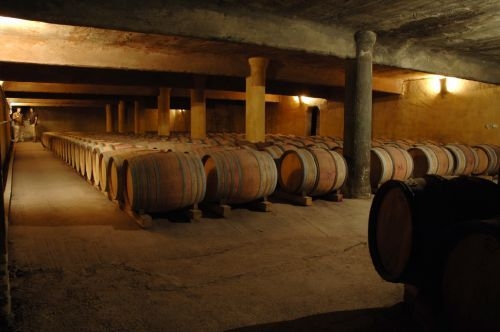 Mas de Daumas Gassac barrel cellar. French oak used not to influence taste but to enhance age-ability.
Mas de Daumas Gassac barrel cellar. French oak used not to influence taste but to enhance age-ability.
The Cellar
When the grapes are harvested by hand, they are then deposited via gravity into the underground fermentation cellar via a trapdoor which is up top at ground level. The fermentation cellar used to be an underwater tank. “We took what existed and made the best of it,” says Guibert, emphasizing that the whole process from sorting to destemming to macerating is all moved along purely by gravity and all done by hand.
This is a process not often seen any longer anywhere, including France. Some of the vineyards in Bordeaux used to use this gravity-fed process but most have since switched to automated. The difference being, explains Samuel, that the less the grapes are manipulated or handled, the better.
Similarly natural and using the resources at hand, the river next to the cellar helps to maintain the cellar at a cool 13-14 degrees C. in Winter and about 17-18 C. in summer with about 70% humidity. “It’s perfect temperatures for cellaring our wines,” says Samuel Guibert.
They only use about 5% new oak. “We don’t use oak to influence the taste of the wine, rather to enhance the capacity to age,” explains Guibert. You will often hear that a Mas de Daumas Gassac – red or white – has an ease of ability to age. “They are wines that can age, I like to say,” says Guibert, noting that the red that you drink and enjoy today will be a different wine from the one you cellar for 10, 15 and even 25 years. Different and perhaps equally enjoyable.
They blend for complex wine. The Guiberts only planted old strains of vines used before cloning, “to ensure traditional flavors and low yields.”Some of the planted vines are pre phyllaxera era and some are grafted onto American root stock. Oenologues refer to the Daumas Gassac vineyard as a “living museum” of Cabernet Sauvignon, Petit Manseng – a varietal that really only thrives in the south west region of France, – Viognier and also a “panoply” of 10% varietals that originate from “Biblical” Mediterranean vines – Israel, Lebanon, Syria, Armenia.
As for the vines that St. Benoit of Aniane planted for the Abbey and Charlemagne, “The existing vineyard that my parents found when they arrived at Mas Daumas in 1970 was indeed extremely ancient but no one can prove if it was the exact same vines as when St Benoit d’Aniane arrived,” says Guibert.
Emile Peynaud, the revered modern genius of oenology, told Mssr. Guibert back at the start of this quest for treasure that he had never been attendant at the birth of a Grand Cru. Forty years later, and we get to enjoy the fruits of that treasure quest.
Mas de Daumas Gassac Haute Vallée Du Gassac 34150 Aniane, Francewww.daumas-gassac.com
*Local Food And Wine*
FACEBOOK/LOCALFOODANDWINE
*****************************************************************************
Terrasses du Larzac
The appellation, Terrasses du Larzac, is the Languedoc’s “new El Dorado.”
“The aim of French AOC wine law is to lend a sensual print to rock, stone, slope, and sky,” – Andrew Jefford, The New France
Terrasses du Larzac is a relatively new appellation – AOC status since the 2004 harvest– in the Hérault region of Languedoc-Roussillon in Southern France. In this sense it is absolutely reflective of the Coteaux du Languedoc’s re-establishment of the quality and prestige of its region’s vineyards, winemakers and especially its wines.
The Domaine de la Sauvageonne’s 2006 ‘Les Ruffes’ wine was placed in the top 100 wines of 2008 in The Wine Spectator, the leading USA wine magazine. Not only a tribute to the Domaine and its Director, Gavin Crisfield, this is proof of the quality potential in the Terrasses du Larzac.
The Terrasses du Larzac is a V-shaped area spreading from the Pic Saint Baudile, its cliffs and benches, that graduates on downward to the point of the V towards Aniane and Lake Salagou. The area encompasses 32 communes (villages such as Saint Jean de la Blaquière, Puechabon, Lodève, St.-Jean-de-Fos…) and produces some 75,000 hectoliters of AOC Languedoc, and only 9000 hl of AOC Languedoc -Terrasses du Larzac, annually. While the highest points of the natural boundaries of the Terrasses du Larzac reach over 800m high, the only planted and permitted AOC zones are between 50m and 300m high on the foothills of the Causse.
Terroir
The distinguishing factors of the Terrasses du Larzac, in addition to its elevation relative to the rest of the low-lying Languedoc, are its soils and its cooler diurnal temperatures.
Soils: Schist, sandstone and sedimentary rock from the Primary epoch characterize this rocky, stubbly soil that French vines seem to feel most comfortable in, as well as soil from old alluvial terrasses and spreading talus washed down by water from the Quaternary epoch. Vestiges of the red, volcanic earth, “les ruffes,” – origins as yet unexplained – are found in the soils of vineyards as far apart as Aniane and St. Jean-de-la-Blaquière.
Climate: Day and night time temperatures can vary enormously, as much as 13°-14° Celsius during the summer months due to maritime influences (as opposed to 11° C at the coast). This coolness and fluctuation is also attributed to the fresh air sweeping down from the Causse.
Olives have long been planted in the area as well as vines, which date back some 2,000 years. Sheep graze on the garrigue – heather, juniper, lavendar, thyme, fennel – of the predominantly limestone plateau and mountainside whose milk is then curdled, cultivated, fermented in dark, damp caves to yield the delicious roquefort which pairs so heavenly with the wines that fall under this AOC Terrasses du Larzac appellation, designated only for reds.
Small Stone Shelters and Dry Stone Walls Everywhere
Local records from the XVI century show that inhabitants owned at least one patch of vines which were often planted amongst fruit trees, as well as olive and almond trees. The fruit was for consumption while the vines brought in cash. This is why still today you can find small stone shelters and walls all throughout these lands dating back to these times and even earlier.
Listed by Quebec Liquor Control Board
Domaine Croix Chaptal : the Cuvée Charles, which celebrates its tenth anniversary this year, has been listed by the Quebec liquor control board. Vigneron Charles-Walter Pacaud is thrilled to be the first to carry the Terrasses du Larzac colours in ‘la Belle Province’.
Wine Writers Have Taken Notice
It is no wonder, then, that the big names of those whose pens are employed by their devotion to wine, have recently, as in the past several months, taken notice of the region:
From London’s Financial Times, Jancis Robinson wrote on June 5, 2010:
“For wine consumers, especially those who like hand-crafted, highly individual wines that express the place where they were grown and are sensibly priced too, Languedoc-Roussillon is the perfect playground.
And Andrew Jefford had this to say on June 19th 2010 in the Financial Times Report:
“The notion that anyone might buy Languedoc wines as an investment would have seemed laughable until very recently”, He continues: “It seems plausible to me that the best sites of the Languedoc might, a few decades hence, produce red wines to challenge the best from Côte Rôtie, Cornas and Châteauneuf. The range of varieties which flourish there is identical, and Languedoc wine at its best combines perfumed enchantment (a northern Rhône trait) with palate breadth and texture (more typical of southern Rhône warmth).”
According to Vincent Goumard, President of the Terrasses du Larzac syndicat there are currently 45 individually owned cellars and 4 cooperatives or “caves cooperatives,” which produce wines under the guidelines that qualify for AOC Terrasses du Larzac designation.
Robert Parker’s updated Wine Buyer’s Guide no. 7 and David Schildknecht’s Wine Advocate includes in its Outstanding Category ten entries from the Languedoc, three of which are from the Terrasses du Larzac region, though not all producing under the AOC designation: Mas Jullien, who is credited with coining the term Terrasses du Larzac but who produces under Coteaux du Languedoc;
Olivier Jullien is a pioneer of the Languedoc. When he took over the family domaine in 1985, he was one of the only believers of the potential of the Terrasses du Larzac (large terraces on the edge of the Cevennes plateau) to produce great wines from the Midi. 25 years later, he controls over 18 hectares of unique vineyard sites, managed following the principles of Biodynamic winemaking. Read More Here
La Peira en Daimasela who has drummed up a bit of a cult following amongst his English compatriots in the motherland; and, Domaine de la Grange des Pères the area’s old venerable, whose vineyards are all in the Coteaux du Languedoc appellation but because he uses some Cabernet Sauvignon in his blends, his wines don’t carry that AOC label but rather the Vin de Pays label (V.d.P. de l’Hérault).

Domaine de Familongue produces their reds under the AOC Terrasses du Larzac designation in St. Andre’ de Sangonis. Their 3 Naissance ’07 (so named because of the three births of proprietor/winemakers Jean Luc and Martine’s three children) is a deep and bright crimson colored, flawlessly tannic red with light liquorice notes that should be chosen for subtly spiced red meat dishes.
For this wine they hand pick the grapes at optimum ripeness after sorting vine by vine, and by hand. No fertilizers or herbicides are used. It is then 100% barrel fermented, de-stemmed and crushed with a long (5 week) maceration. They use only new and second-fill barrels, entirely European oak, for this vintage. A wine to drink today and to keep for 5-10 years. It won the Gold Medal for the Grand Vin du Languedoc 2009. It also took a Bronze from Decanter and is listed in the 2010 Guide Hachette. Their label shows a parrot because they keep 30 of them on their property. They also cultivate 9 hectares of olives from which they produce absolutely divine olive oil. Both their wines and olive oils can be purchased at the winery or online.
For a listing of 30 + wineries in and around the village of Aniane, visit:www.salondesvinsdaniane.com
TWITTER.COM/LOCALFOODWINE
*LOCAL FOOD AND WINE*
FACEBOOK/LOCALFOODANDWINE
*************************************************************************
Boutargue, Mediterranean Caviar
This is an ancient delicacy originating from the Mediterranean Sea. It is made from compressed fish eggs, silver mullet roe, to be exact. The roe is cured and dried to perfection using sea salt and then embalmed in a wax coating to seal in its flavor and freshness.

It costs about $200 per kilo but since it is meant to be eaten as a flavor-packed appetizer, you can buy it in lesser quantities and still enjoy generous portions.
The boutargue itself varies in color from yellow to orange to a burnished brown, though with the wax encasing it first appears as an odorless, colorless sausage.
This is such an ancient dish that it dates back to the 6th Century B.C.E. when the Phoenicians imported it into Provence when they founded Marseille. Still, the Greeks, the Italians (Botarga in Italian) and the Egyptians dispute the origin of the “caviar” delicacy.

In Corsica, Boutargue is enjoyed during the Christmas season. In Italy, they like it shaved thin on their spaghetti. In the South of France, in Martigues near Marseille, where it is the traditional dish, it is relished in thin slices, drizzled with olive oil and lime, served with green olives and crackers and accompanied by Arak, Pernaud, chilled Vodka or Fig Liquor.
TWITTER.COM/LOCALFOODWINE
*LOCAL FOOD AND WINE*
FACEBOOK/LOCALFOODANDWINE
******************************************************************
You Say Tomato, We Say Tomate!
In case you missed it, July 3rd was a day to celebrate the beautiful, the wonderful, the full red-ripe and juicy glorious tomato at the Fete de la Tomate. In the south of France, on a day when both Canada and the U.S. were celebrating their days with fireworks and picnics, hundreds of farmers and locavores gathered in reverant, festive celebration of the Heirloom tomato, in all its thousands of varieties.
It’s hard to imagine that anyone could know tomatoes better than the Tomatologue knows tomatoes. This is a tomato devotee who not only grows about 1200 different varieties of tomatoes, but someone whose eyes light up as he gingerly hands you the freshly cut slice of tomato from one of his artisanal varietals and watches as the delight sweeps across your face, dancing in harmony with the sensorially exquisite taste of the tomato in all its fullness of flavor as it bursts from the fruit and splashes over your tastebuds.
Twitter.com/localfoodwine
*Local Food And Wine*
FaceBook/LocalFoodAndWine
*********************************************************************
- Corsica – L’île de Beauté
-

- Cape Corsica.

Corsica, off the French south coast, produces delicious dry white and subtle rosé wines that are best drunk chilled, young and fresh as an aperitif or to accompany light meals of seafood, salads, tapas.
Wine of Corsica is the common appellation to all the wines of Corsica, with the following AOC classifications related to either the soils or the villages in which the vineyards are grown: Ajaccio, Calvi, Coteaux du Cap Corse et Muscat du Cap Corse, Figari Patrimonio, Porto-Vecchio, Sartène.
While Corsica is definitely “south of France,” it does not fall under the newly minted branding of “Sud de France,” a term that is being used by the region of Languedoc-Roussillon as they voyage forth once again onto the world export stage with their wines and other agricultural products.
Corsican wines are one of those “well-kept secrets.” The island, which the French call “L’île de Beauté,” produces some great wines but they aren’t exported much overseas…yet. Set in the Mediterranean Sea, many of the island’s wines originate from Italy. The sun’s reflection on both white rocks and the Mediterranean brings even more energy to the vine which, combined with low yields, will eventually produce a very concentrated grape.
- Cap Corse Wine This white wine is pretty rare and much appreciated by winelovers. Many agree that it is the best white wine in Corsica.
- Sartene Wine This is an excellent wine, and the red San Michele is definitely a must-taste. These are fruity and warm Corsican wines.
- Patrimonio This wine is as famous as the classic Corsican appellation and its quality is constantly growing. Corsican reds and whites are increasingly famous even out of the island. Patrimonio rosé wines are also fine wines. Patrimonio wines have a pretty strong character that originate from the soil, which is composed mostly of clay and limestone. This Corsican wine is full-bodied but still light and fruity.
- Ajaccio The Ajaccio French wine boasts the distinction of being the most elevated wine region in France. Most of its vineyards are located 500 m and above. This Corsica wine benefits from the warm weather, and the sea air provides it with a very particular flavor too. This French wine fully benefits from the Corsican environment thus it is light coloured, fruity and has a pronounced pepper flavor in the mouth. The Ajaccio soil is mostly granite.
They also have excellent beaches in Corsica!
*Local Food And Wine*
FaceBook/LocalFoodAndWine
********************************************************************
La Fête des Rosés & des Blancs
Two prevailing characteristics of the Languedoc-Roussillon are that the region is steeped in history, specifically wine history, and it is known for its ripe, red wines.
But this once again up-and-coming wine region is taking its future in its own hands by using innovative approaches to freshen up its image. One of those approaches is to celebrate its vineyards’ white and rose’ wines.
In June and then again in November, the wineries of the region are encouraged to throw open their doors to tasters and wine buyers to especially highlight their rose’ and white vintages.
Back in the region’s heyday, during the XVII c., wines of the Midi, particularly its Muscats, and especially its Muscats secs, rivalled the wines of Burgundy. Wines from St. Georges d’Orques, a village where wineries still operate today, were known from border to border throughout France.
On a tasting of the Greater Languedoc region, these are some wines you ought to get the chance to try:
Cave de Roque Brun, St. Chinian. They are in the Guide Hachette and have won a Gold Medal in Paris’s Concours Generale Agricole.
Domaines de Gallieres, a new vineyard that presented its “Salsa de la Vigne” at this year’s tasting festival, a light-hearted rose’ that pairs well with melon, prosciutto, feta wrapped in marinated red peppers.
Domaine Pibarot in Mus who handpicks their grapes and uses no pesticides.
Domaine du Silene. Legend has it that an effigy of Silenus, the tutor to Dionysius the Greek God of wine and the grape, was found on the premises and watches over the estate. Vineyards thrive in the exceptional clay and limestone soils.
Domaine de Montnegre whose Rose’ is under the AOC Coteaux du Languedoc and made by blending Syrah, Grenache, Cinsault. Fresh and aromatic, it pairs well with light repasts. Their white, a blend of old Carignan blanc and Ugni blanc, is vin de Pays.
Le Domaine Puech, in Saint-Clement-de-Riviere, is a local favorite. Their Vin de Pays d’Oc Chardonnay with a floral, vanilla nose and a well-balanced, ample mouth.
Les Chemins de Carabote has a Terrasses du Larzac which exhibits both strength and elegance, richness and complexity. Featured in Guide Hachette.
Les Vignerons du Pic offers their “Gres de Montpellier,” which is their wine that’s on the map.
The AOC Gres de Montpellier was obtained in 2003 and encompasses most of the villages that are situated in the “Agglomeration” Montpellier. With this classification, the vineyards of the region are re-exerting and re-establishing their importance in the national culture of wine.
Domaine Jordy, which can be found in Le Bosc, keeps 500 hectares of vineyards under cultivation amidst 2500 hectares of garrigue, the native Mediterranean scrub brush thought to lend its aromatics of thyme, rosemary, lavendar to the wines. To keep with their whites and rose’s try the Cers Vent, Viognier and Rose’ cuvee’ speciale, as well as their Blanc vendanges passerillees for a dessert wine.
*Local Food And Wine*
FaceBook/LocalFoodAndWine
**********************************************************************
Domaine de Saumarez
Living The Dream In The Languedoc
Robin and Liz Williamson are enviable people. Both hail from other parts of the planet, Liz from New Zealand and Robin from the UK, but they’ve planted their home, and wine business, amidst the vineyards of the Midi.
Just outside Murviel-les-Montpelliers, and not too far from St. Georges D’Orques, both villages in the heart of the Languedoc-Roussillon in Sud de France, perches Domaine de Saumarez on a pretty hillside whose sweeping views take in the Mediterranean Sea in the not-too-distant yonder.
In 2006, the winery’s top cuvee’, their “Aalenien, ’04” earned a full-bodied 92 points from Wine Spectator (Kim Marcus, 2006). “2009 is going to be another spectacular vintage,” says Williamson. Indeed, there’s not a soul in France today who isn’t singing the praises of the 2009 vintage year. As for 2010, “It was a hard winter but the vines seem to be quite happy now,” he says.
It was nearly a decade ago when Liz and Robin decided to shuck everything – him his banking career, her, accounting – and pursue their passion of wine. After repeated and extended wine tasting trips throughout the world and France, they settled on looking for a vineyard to call home in the region between the Spanish border and Nimes. This region, the “Midi,” or Languedoc-Roussillon, is the hub of wine making in France. It’s not its most celebrated, but it is its most voluminous.
“We looked at 30 domains from the Spanish border all the way to Nimes. This was number 30,” recounts the Williamsons who are raising their two young sons up on the vineyard. “The winery had potential, even though it was a wreck,” reminisces Robin, pointing out that there was no roof on what is now the cellar and tasting room when they bought the estate back in 2003. By 2004 they had produced their first vintage. They sold their first bottles in 2006.
“Aalenien,” is not just the name of Domaine de Saumarez’s top cuvee’, it is also the name of the type of soil to be found on the property. The rocky soils are made up of Jurassic limestone that have bands of quartz running through them. This soil, found in about a 10 sq. km radius, is particular to Murviel-les-Montpellier, the 2,500 year old Roman-Gallo village that the Domaine is situated in. At its height, Murviel had 15,000 inhabitants and was one of the main towns on the ancient route traveled between Spain and Italy.
The soil makes for minimal weed growth, hence little need for pesticides nor weed killers; it is good with heavy rains because the rocky limestone is very porous yet it retains moisture at about 1 to 2 meters below the soil surface, thus keeping the vines hydrated. The region’s 300 days of sunshine per year and tendency to get high winds dries out the vines.
The Languedoc region is also known for having numerous organically farmed vineyards and in fact the region as a whole is becoming specialized in organic. It has some of the highest concentrations of organic agriculture, and viticulture, in all of France. Domaine de Saumarez is no different and will be certified organic by 2012.
Robin Williamson is the type of vintner who likes to know what he’s talking about. And he does. Before he and wife Liz bought the farm, he spent two years taking courses in oenology in Brighton. He finished his studies at the level just one shy of Master in Oenology. He’ll gleefully talk to you about stirring the lees – “batonage” – and discuss with you the merits of using food-grade fiberglass fermentation tanks and square concrete ones for the reds and why they use mostly French oak barrels with only two American oak barrels thrown in the mix…But mostly he’ll tell you, “We’re farmers you know, no more or less, than farmers.”
He characterizes this as an “Old World” approach to winemaking. “In France the vigneron is still more Old World. We do it all. We’re farmers. We’re winemakers. We’re wine sellers.” He concedes that as a grape farmer and winemaker you need to remain philosophical about certain things, like the weather. “You have to always stay on the front foot,” he says, reverting to a cricket-ism.
Domaine de Saumarez makes four wines. Their top cuvee’ the Aalenien, a red. Notes of herbs, spices, minerals, olives and flowers. Their Domaine S’ red – supple, ripe, lush with a spicy edge – and their Domaine S’ white, – minerality and class, grapefruit, lemon peel that leads into a creamy width – all Coteaux du Languedoc AOC and a rose’, the Fleur de Liz, also AOC, vins de Pays de l’Herault. As a red wine with the Coteaux du Languedoc AOC classification, it will have some or all of only these varietals: Grenache, Syrah, Mourvedre, Carignan, and Cinsault.
*Local Food And Wine*
FaceBook/LocalFoodAndWine
***********************************************************************
Pic Saint-Loup, Languedoc-Roussillon
Pic Saint-Loup in Côteaux du Languedoc produces some of the finest wines in the Midi. As a sub-appellation of the Languedoc AOC, it is petitioning vigorously, and successfully, to become its own appellation. Many foresee that it soon will succeed in these efforts.
“The vignerons of the Pic Saint-Loup have been smart to identify their appellation with the majestic mountain of Pic St. Loup,” comments a compatriot winemaker from the Murviel-les-Montpellier sub-appellation just to the south of Pic Saint-Loup.
The Coteaux du Languedoc appellation was replaced by the appellation Languedoc AOC in 2007, but the two names will run concurrently until 2012.
The majestic peak of the St. Loup mountain is a dominantly identifying landmark for this notable region in Sud de France and it conveys the inextricably linked mark of the terroir, that of its cooler elevated vineyards which are set apart from the lower, and hotter, Languedocien plains.
The Pic Saint Loup and Hortus mountains are at the cross-roads of Legend and History. According to a children’s story, they were born from the blow of a club given by a giant who had flown into a terrible rage. Since then the mountain weeps from the Mascla spring. Pic Saint Loup also evokes the name of the sainted knight Loup who, in memory of his lady, became a hermit, singing his undying love from the top of this rocky peak…This is a land of vines and olive trees, crossed by shepherds and coal makers of every origin supplying the cities on the sea shore with wool and charcoal…
READ the complete Myth And Legend of Pic Saint Loup Wine Region on Domaine de l’Hortus
Thirty kilometers from the southern French coast, the climate is Mediterranean with the characteristic aromatic haut garrigue perfuming the terrain. The topography of the area, dominated by these two distinctive mountain peaks – Montagne de l’Hortus and Pic St. Loup itself – to the north and east means increased diurnal temperature variation which is an essential factor in the development of balanced acids and sugars in the wine grapes.
The Pic St. Loup is only red and rosés. White varietals are grown in the appellation but are not bottled under the Pic Saint Loup AOC classification. Only reds are honored with that with the whites receiving a Coteaux du Languedoc, or the local Vin de Pays du Val de Montferrand also for the roses.
In fact they wineries have been quite strict in setting up their qualifications for the sub-appellation AOC:
The principal grapes must be Grenache, Mourvedre and Syrah; a vintage must contain at least two and must comprise at least 90% of the blend. At least 20% of that must be Syrah, a vine that is not indigenous to the area, but was planted early last century, along with Mourvedre and Grenache, as cépages améliorateurs, during the re-planting of the country’s vines. Maximum yield is 45 hl/ha, minimum alcohol is 11.5% and the vines must be at least 5 years old. These conditions will only become steeper when the INAO accepts their petition for AOC classification. Other varieties in the blend can be Carignan and Cinsault which are allowed a maximum of 10%.
The mesoclimates of this limestone dominated terroir allow for the viticulturists to plant the heat-loving Mourvedre in the warmer, lower vineyards and use the higher vineyards to grow a more elegant style of Syrah, which responds well to the cool mountain nights.
- Size: 13 villages north of Montpellier, stretching 25 km north–south and 10 km east–west
- Area of production: 1500 hectares, with 800 ha planted to Grenache, Syrah and Mourvèdre
- Producers: 3 caves co-op, 36 (and counting) individual producers
Lascaux is French for limestone rock, and Jean-Benoît Cavalier has 35 hectares of vines on a series of stony terraces located just north of the village of Vacquires. He took over from his father in 1984 and is now one of the leading growers in the appellation. His best wine, Les Nobles Pierres, is a blend of 80% Syrah and 20% Grenache.
Andre Leenhardt of Chateau de Cazeneuve first came to the area with the intention of starting an herb nursery. After surveying the terrain he changed his plans and bought, instead, an existing wine estate. The wine “estate” consisted of a IX century edifice that stood in the heart of this ancien viticulture region. Andre took it from there…
That was back in 1987. He keeps his yields low, approximately 25-30 hl/ha and harvests by hand. He maintains 80% red varietals and 20% white varietals under cultivation, with the entire domaine under Pic St. Loup AOC classification.
Chateau de Valflaunès, Clos Marie, Mas Bruguière…MORE
*Local Food And Wine*
FaceBook/LocalFoodAndWine
************************************************************************
Clairette du Languedoc
Many people know claret as a sweet white wine the English liked to drink back in the day. But this old-fashioned vine has the prestige of being the varietal found to have been cultivated on the oldest European vineyard discovered to this day.
That vineyard is in Aspiran, the Languedocian village in Sud de France. It once belonged to Quintus Iulius Primus who maintained the claret vineyards under cultivation as early as the year 10 A.D. when nearby Bezier was still a Roman outpost. The varietal is indigenous to this Languedocien region in the Herault.
In 1948 Clairette du Languedoc was pronounced its own Appellation d’Origine Controlee (AOC), the first in the region.
Claret, both the dry white and sweeter varieties of the wine enjoyed popularity all throughout the Middle Ages. It is said that Rabelais and Oliviers de Serre both mentioned “Cleretz,” also called “Hypocras,” in their writings. At nearby Montpellier Rabelais lectured on the ancient physicians, Hippocrates and Galen. In 1532 he was a physician at Hôtel-Dieu, a general hospital in Lyons, the city that was France’s commercial and cultural center at the time. In the same year he published his famous comedy, Pantagruel, under the pen name Alcofribas Nasier – an anagram of Rabelais’s real name.
French Renaissance writer, Franciscan monk, humanist, and physician, whose comic novels Gargantua and Pantagruel are among the most hilarious classics of world literature, François Rabelais’ heroes are rude but funny giants traveling in a world full of greed, stupidity, violence, and grotesque jokes. The true target of his satire was the feudal and the ecclesiastical powers, and the world of the learned. Rabelais’ books were banned by the Catholic Church and later placed on The Index librorum prohibitorumon (the Index of Forbidden Books). … Read More Here
During the Renaissance, in 1533, Francois The First drank claret wines in Beziers. It is said that when Moliere spent a winter in Beziers ca. 1654 he drank the famous Hypocras, “clairette moelleuse” of the age.
Claret vines like the hot, arid conditions and poor, dry soils of the Mediterranean. It tends towards high alcohol content and is often referred to as clarette blanche and blanquette. The wine was big business for the Hérault region all through the Middle Ages. After the French Revolution, claret began losing its market share in European trade. It wasn’t until 1900 when, due to phylloxera, claret vineyards fell into declining production.
Today, in addition to Aspiran, where Chateau Malautie‘ grows claret vineyards right next to the fields once maintained by Quintus Iulius Primus two thousand year ago, you can also find wineries producing claret in the villages of Adissan, Le Bosc, Cabrières, Ceyras, Fontès, Lieuran, Cabrières, Nizas, Paulhan, Péret, and St-André-de-Sangonis. There’s about 70 hectares in total under cultivation in this appellation.
In addition, claret makes (minor) appearances in blends including Châteauneuf-du-Pape, Tavel Rosé, Côtes-du-Rhône, Lirac and Blanquette de Limoux. Clairette du Languedoc production centers may also produce red or rosé Coteaux du Languedoc wines.
The archeological Museum, Musee‘ Archaologique Lattaria, in nearby Lattes, just wrapped up a half-year long series of conferences, “Wine, Nectar of The Gods, Muse of Men.”
*Local Food And Wine*
FaceBook/LocalFoodAndWine
*********************************************************************
Mmmm Is For Wine
- Mediterranean climate: A climatic condition in which the summers are normally dry, warm to hot and sunny whereas winters are mild with the maximum rainfall taking place during this time of the year. In grape growing terms, Mediterranean climate is prized for its reliable growing season characterized by plenty of sunshine and heat. The lack of humidity is also helpful to prevent fungal diseases. On the negative side, the vines may be stressed due to the lack of moisture necessitating irrigation. The must-weight (see below) can also precariously increase in this heat for light table wines although the condition suits perfectly for the production of dessert and ‘fortified wines’.
- Mesoclimate:

- French Mediterranean Aromatic Garrigue.
- A term which refers to the climate of a particular grape-growing site, which can be as broad as a village (commune in French), clusters of vineyards on a slope or as specific as a particular vineyard site or a part of a large vineyard. It is an intermediate scale between macroclimate (see above) and ‘microclimate’.
- Micro-oxygenation: Is a winemaking technique that allows small, precise and controlled amount of oxygen to come in contact with the wine. Although the process has various implications depending on the stage of the vinification, it is a particularly effective method to soften red wines with high and aggressive ‘tannins’. A controlled amount of oxygen assists in the polymerization (binding) of these harsh ‘phenolics’ thereby mellowing them. Micro-oxygenation also helps in stabilizing the color in red wines by assisting in the polymerization of ‘anthocyanins’ and tannins. Other benefits include propagation of a healthy yeast population to avoid a ‘stuck fermentation’ and also to reduce any off flavors produced due to the lack of enough oxygen during fermentation.
- Microclimate: Precisely, microclimate refers to the climatic conditions surrounding the immediate vicinity of the vines. A very fine grained description, it encompasses the conditions within the vine canopy including, but not limited to grape bunches, leaves, shoots, the soil temperature and so on. It is an extremely important tool that dictates various vineyard practices with an aim to match the vine’s performance to the local conditions.
- Malolactic fermentation: Simply put, a winemaking process to reduce the harshness of a wine due to the presence of natural acids in the wine. It is also thought to impart added mouthfeel (see below) to the wine. The actual process involves the conversion of strong malic acid to the softer lactic acid through the action of lactic acid bacteria. It is sometimes referred to as ‘Malo’ in wine jargon.
- Mouthfeel: A broad term used to denote a wine’s taste sensations in the mouth. More technically, it is the interaction of the wine’s components with the receptors in human mouth that determine the taste of a particular food or drink. There are numerous perceptions that may be included when mentioning mouthfeel, like ‘smooth’ ‘light’, ‘heavy’, ‘dense’, ‘viscous’, ‘grainy’ and so on.
- Must: Is the grape juice containing the solid matters of the fruit after crushing; skins, seeds and stems (if allowed to stay in the juice).
- Must weight: Is the measure of grape ripeness in terms of the amount of dissolved fermentable sugars which will decide the ‘potential alcohol’ of a wine. Various units are used to measure the must weight of grapes but Brix, Baume and Oeschle are the most common.
- Mutage: Is a winemaking process to artificially stop or prevent the alcoholic fermentation of grape juice or ‘must’ which results in a wine with high levels of natural grape sugar. It involves creating an inhospitable environment for the yeasts, either by the addition of grape spirits or less commonly, sulfur dioxide.
When mutage is carried out before the start or after a short period of fermentation, it results in a wine often referred to as ‘vin doux naturel’. ‘Fortified wines’ like port are produced when the fermentation is stopped by mutage during fermentation.












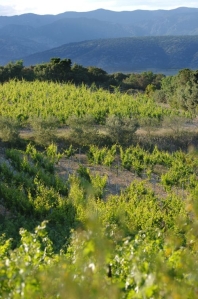
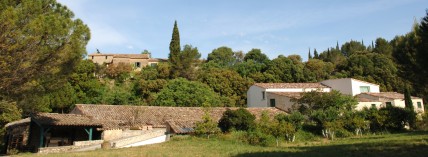


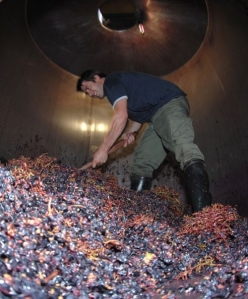

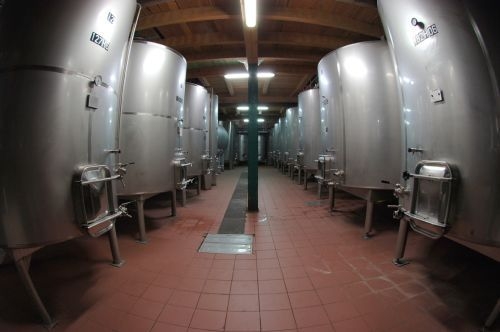
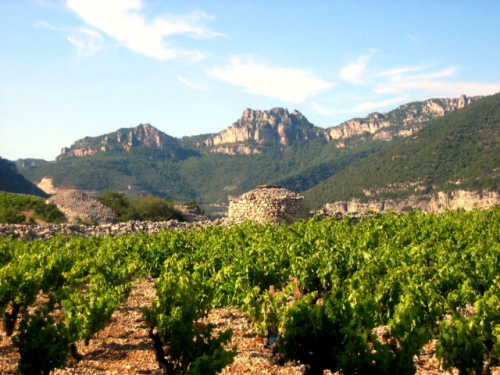

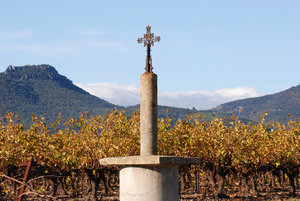















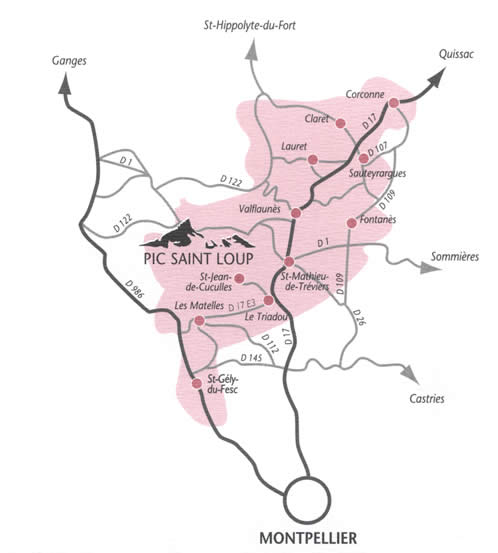







Gorgeous Stuff!
Maintain up the great work mate. This website article shows how well you comprehend and know this subject.
I believe the destiny of your generation-and your nation-is a rendezvous with excellence.
Genuinely definitely very good website article which has got me wanting to book one of your Local Food And Wine Tasting Tours!
I’m grateful for you because of this good written content. You definitely did make my day : )
congratulations page for the new look of wesite
jean-luc de la Grande Motte
Helloc’est cool de trouver du monde avec le meme avis à ce sujet, je repasserait plus souvent.
Thanks for this! I’ve been searching all over the web for the info.
You could certainly see your expertise in the paintings you write. The world hopes for more passionate writers such as you who aren’t afraid to mention how they believe. Always follow your heart.
thanks !
Excellent post. I was checking continuously this
blog and I am impressed.